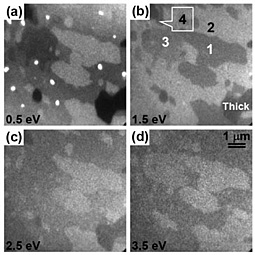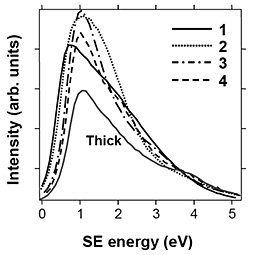Materials Science Laboratory, *Physical Science Laboratory
Graphene is attracting intense attention as a future electronic material
due to its superior electronic transport properties. Epitaxial few-layer
graphene (FLG) grown on SiC by thermal decomposition can be easily scaled-up
and is promising for device integration. However, it is still difficult
to grow epitaxial FLG to an intended thickness. To overcome this problem,
we have developed a method for evaluating the number of graphene layers
NG in epitaxial FLG microscopically using low-energy electron microscopy
(LEEM) and have used it to control the growth [1]. For device applications
of epitaxial FLG, it is also important is to clarify how the SiC substrate
influences the electronic properties of FLG. The influence of the substrate
results in the NG dependence of the electronic properties, which was investigated using
spectroscopic photoemission and LEEM (SPELEEM) at SPring-8 [2].
Figure 1 shows photoemission electron microscopy (PEEM) images of epitaxial
FLG grown on 6H-SiC(0001). The PEEM images were made by secondary electrons
(SEs) emitted under irradiation of photons of 400 eV. Numbers indicated
in (b) are NG values determined by LEEM. Areas with different NG can be discriminated in the SE PEEM images, but their relative intensities depend on the SE energy. Figure 2 shows the SE emission spectra obtained from the sequential SE PEEM images at different energies. The SE emission spectra depend on NG in two aspects; the threshold start voltage of the SE emission and the spectrum shape. The threshold voltage corresponds to the vacuum level. Monolayer graphene has a work function about 0.3 eV smaller than bulk graphite, and the work function of epitaxial FLG increases with NG. The NG dependence of the spectrum shape is explained by unoccupied electronic
states in epitaxial FLG discretized due to its finite thickness. Similar
experiments for C1s core level photoelectrons indicated that the C1s binding energy also depends on NG. The NG dependences of the work function and C1s binding energy are consistent with the shift of the electronic structure
of epitaxial FLG caused by the electron doping from the SiC substrate [3].
[1] H. Hibino et al., Phys. Rev. B 77 (2008) 075413; H. Hibino et al., e-J. Surf. Sci. Nanotechnol. 6 (2008) 107.
[2] H. Hibino et al., Phys. Rev. B 79 (2009) 125437.
[3] T. Ohta, A. Bostwick, T. Seyller, K. Horn, and E. Rotenberg, Science
313 (2006) 951.
 |
 |
|||||
|
|